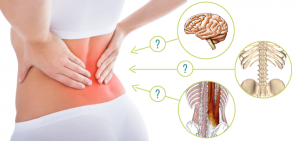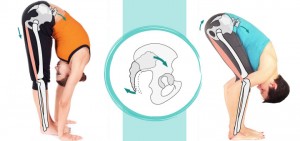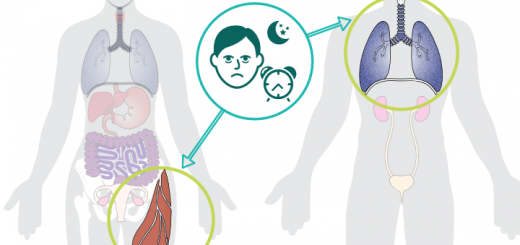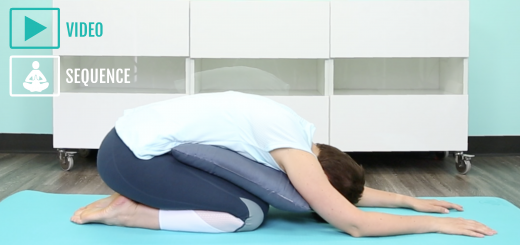
Whenever you plan to work with lower back and sacrum in your yoga class or private yoga session, it helps to remember the following important points:
- Your lower back and your abdominal muscles have an agonist-antagonist relationship: when one is contracting, another one as passively stretching. Mastering progressive abdominal contraction in your yoga practice creates support for your lower back, builds stronger core, creates better alignment and encourages deeper awareness.
- The L4-L5 junction (a place between last two lumbar vertebrae) is the most mobile and the most weight-bearing, which also makes it the most vulnerable. When we bend back, we need to avoid creating a pivot point at that juncture. Instead, we need to focus on distributing the curve throughout the spine to make our back bends more safe and effective for back strengthening.
- Lower back discomfort can show up for all sorts of reasons. Sometimes it stems from structural damage, such as a herniated disk, and sometimes it shows up in response to how we use our bodies in our daily lives. And sometimes it can be due to dysfunction in your sacroiliac joints, which could be linked to hormonal fluctuations.
- Advanced asymmetrical postures done without proper preparation, too many asymmetrical postures in a row, or locking your knees in deep forward bends can all stress our sacroiliac joints and cause pain. We need to avoid those things in our yoga practice.
- You cannot effectively strengthen your ligaments, so when you work with the sacrum area in your yoga practice, you need to release tension in the muscles that link to the sacrum and strengthen the surrounding structures.
- Recent science on chronic pain states that the experience of pain anywhere in the body has very little to do with the actual tissue injury. And the longer the pain persists, the less it is connected to the state of the tissues. Multiple body systems are involved in the experience of pain, so the healing needs to happen on multiple levels also. It’s a good thing that yoga has tools that affect the body on different levels, way beyond just basic stretching and strengthening. That is why yoga is very effective for chronic pain management.
Sequence Wiz blog posts about lower back and sacrum

How to protect your lower back and increase stability in any yoga pose
Doing the “zip up” action in back bends protects your lower back, doing it in twists ensures that you twist from the center, instead of using arm leverage, doing it in forward bends takes you deeper into the pose in a safer way, and so on. It’s one of those things that you really shouldn’t go without. Read more >
Is lower back pain gender-specific?
At some point during the 20th century the medical community concluded that since sacroiliac joints were strong, they wouldn’t be prone to spraining or tearing, and therefore, sacroiliac joint dysfunction cannot be the reason for your lower back pain; case closed. Somehow, though, they forgot about the effect that those pesky hormones can have on pliability of the SI ligaments. Read more >
 Recent guidelines about dealing with back pain: do they make sense?
Recent guidelines about dealing with back pain: do they make sense?
A recent article in the New York Times discussed the updated guidelines by the American College of Physicians regarding treatment of lower back pain. The article quotes Dr. Weinstein, who said that patients have to stay active and wait it out. “Back pain has a natural course that does not require intervention,” he said. He added: “I know your back hurts, but go run, be active, instead of taking a pill.” Is that sound advice? READ MORE>

How to bend back without hurting your back
Your lower back is most vulnerable at the L4-L5 junction (a place between last two lumbar vertebrae), which is the most mobile and the most weight-bearing. I read a quote from a spinal surgeon once – he said that L4-L5 junction had bought him a nice house and put his son through college. Many people experience problems in this area. Here is how you can protect it >

Too many asymmetrical poses can create sacroiliac joint issues
Some of us have more mobility in the sacroiliac joints which can create potential problems. Certain things you do in a yoga class can make it much worse. Read more >
 Take care of your lower back and sacrum
Take care of your lower back and sacrum
Once your sacroiliac joints are destabilized, it becomes much easier to irritate them, which means that you would need to take extra care of your lower back and sacrum to keep them happy and pain free. Here are some steps you can take to deal with your current discomfort and to prevent future occurrences. Read more >
Sample yoga practices
 |
 |
 |
New: 6-Week Yoga Series for Lower Back and Sacrum Stability

For your lower back to be happy, healthy, and pain-free, it needs to be strong, stable, and supple, while being supported from the front, sides, and bottom. To build that support, in this yoga series you will:
– Focus on releasing chronic tension in your hip flexors and creating a balanced front-to-back relationship between your pelvis and your spine;
– Develop your core musculature so that it is strong enough to support the weight of the upper body and supple enough to move your body without stressing your lower back;
– Work on restoring a balanced relationship between the sacrum and pelvis and strengthening the surrounding structures that stabilize the sacrum to minimize the risk of it getting displaced.
As yoga teachers, we want to help our students feel better in their bodies. This means that often we need to work with specific areas of tension and imbalance. What does it take to create an effective practice to release tension and increase range of motion in a particular part of the body? Some principles are universal, and some are unique to the target area. Here are some ideas on how you can approach it in your yoga classes, as well as some safety precautions that we need to consider. Check it out >
[jetpack_subscription_form]







Thanks for bringing meaningful content